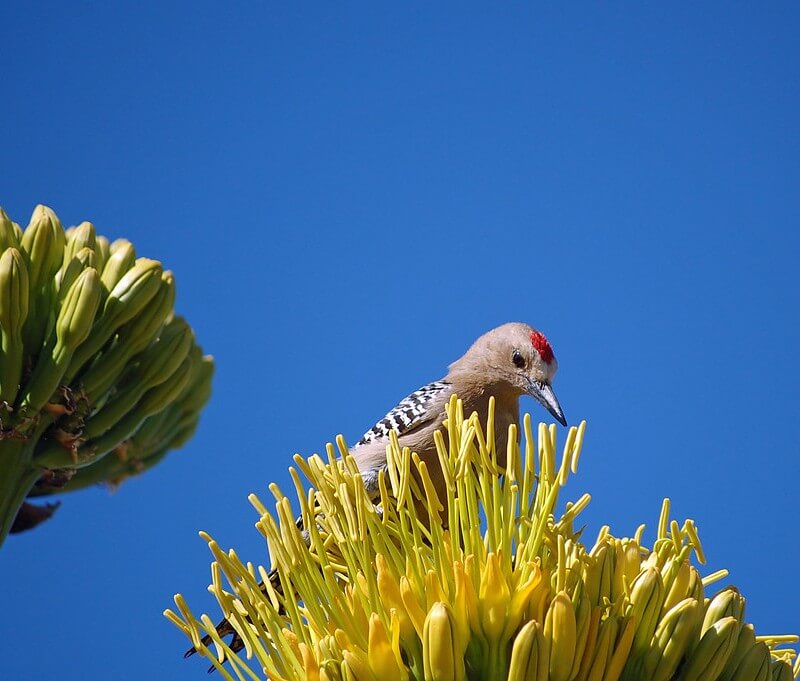Woodpeckers are an iconic species in California, with a wide range of species found in the state. Woodpeckers are found in a variety of habitats, from the coastal redwood forests of the north to the desert scrub of the south. The geography of California provides a variety of habitats for woodpeckers, from the tall trees of the Sierra Nevada to the chaparral of the coastal ranges. Woodpeckers are able to take advantage of the diverse habitats and resources available in California, such as the abundance of dead trees and snags that provide nesting sites and food sources. They also use the varied topography of the state to forage for insects and other food sources. Woodpeckers are important members of the California ecosystem, helping to disperse seeds and control insect populations. They are also a popular species among birdwatchers, providing an opportunity to observe these fascinating birds in their natural habitat.
woodpeckers IN CALIFORNIA
Read on to learn more about the 15 woodpeckers that visit California.
Acorn Woodpecker

- Melanerpes formicivorus
- Size: 8″ (21 cm)
Identification and Color: The Acorn Woodpecker is mostly black, with some white patches on its face and white to gray undersides. A dominant black patch around the bill and a striking red on top. Females tend to have less red than males. They have short and pointed bills.
Habitat and Behavior: Found on the west coast and some southwest states. The Acorn Woodpecker makes oak trees their homes and is rarely found away from those trees. Will live in large groups and store their acorns in holes they’ve created in the oaks.
Diet: As the name implies, the Acorn Woodpecker enjoys acorns but will also eat insects, fruits, and seeds.
What does an Acorn Woodpecker sound like?
Black-backed Woodpecker
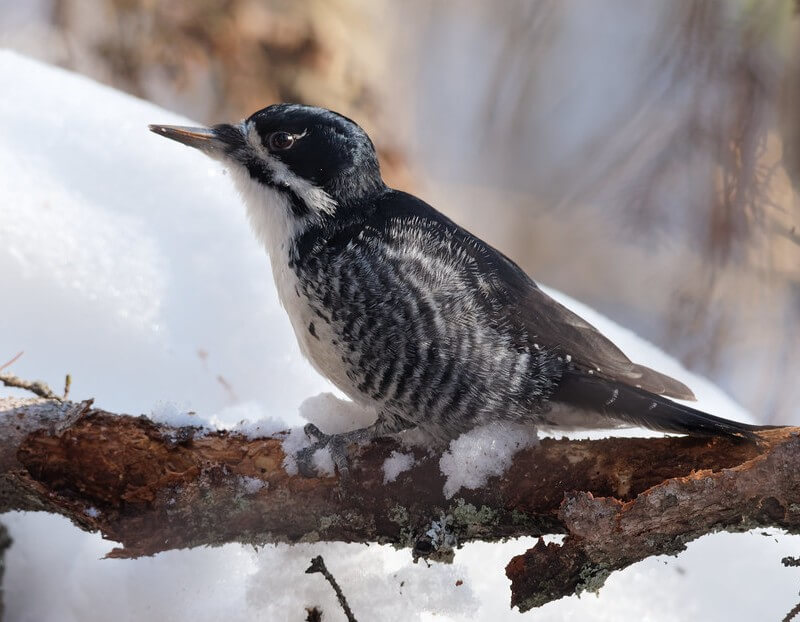
- Picoides arcticus
- Size: 9″ (23 cm)
Identification and Color: Medium-sized woodpecker at about 9 inches in length. They have large heads and large, broad bills. Dark black on top, black and white barring on the wings, and a white underside. A white line runs underneath the eyes. Males have a yellow patch on their heads.
Habitat and Behavior: Typically spends all seasons in the far north. Prefers forests that have recently burned, with dead or dying trees. Will forage in these dead trees for long periods of time to find insects.
Diet: The Black-backed Woodpecker feeds on wood-boring insects like beetle larvae. Will also eat some fruits and nuts.
What does a Black-backed Woodpecker sound like?
Downy Woodpecker

- Picoides pubescens
- Size: 6″ (15 cm)
Identification and Color: Adult Downies are black and white, with a black back, white belly, and a small patch of red on the back of the head. They have a short bill and a barred tail.
Habitat and Behavior: Downy Woodpeckers live in forests, woodlands, orchards, and suburban areas. They are year-round residents in most of their range. They forage on tree trunks and branches, using their bills and barbed tongue to peck at bark to find food.
Diet: Downies feed on insects, spiders, berries, and nuts. Downies sometimes store food by caching it in cracks in trees or other hidden spots. Can be spotted at seed and suet feeders.
What Does a Downy Woodpecker sound like?
Gila Woodpecker

- Melanerpes uropygialis
- Size: 10″ (25 cm)
Identification and Color: The Gila Woodpecker has a grey-brown body, with black and white barring throughout their wings. Males have a bright red patch on their heads. A long and pointed bill. Between 8 and 9 inches in length, they are medium-sized woodpeckers.
Habitat and Behavior: Found in a small area of the southwest desert, they like to be around saguaro cactus and desert scrub. Will forage around the cactus and other vegetation and are very protective of their areas. Will occasionally forage on the ground.
Diet: The Gila Woodpecker is omnivorous, with a diet that includes insects, fruit, and seeds. They will eat cactus fruit, small lizards, and may visit a hummingbird feeder for the sugar water.
What does a Gila Woodpecker sound like?
Gilded Flicker
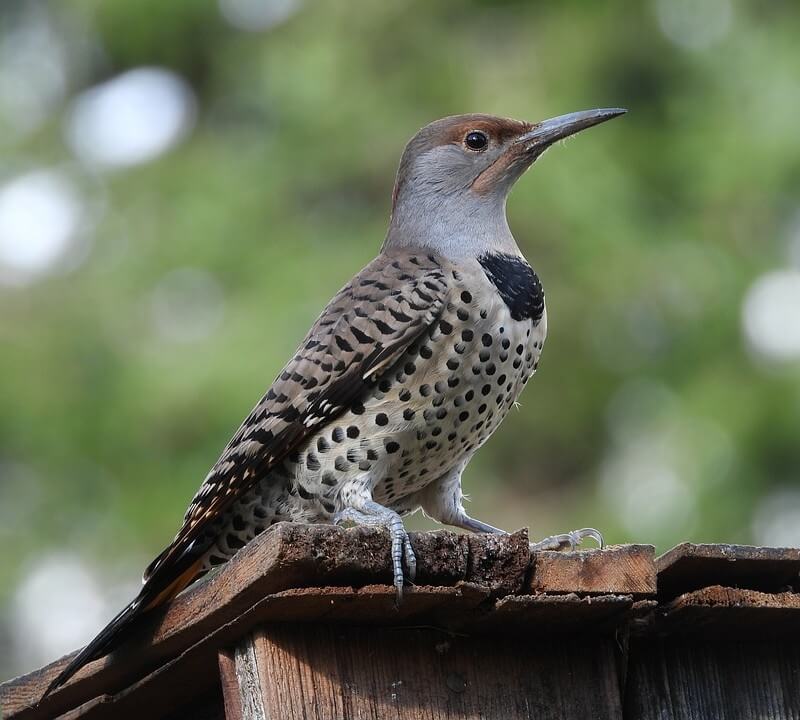
- Colaptes auratus
- Size: 14″ (35.5 cm)
Identification and Color: A large bird with a large bill that curves slightly. The top of the head is a soft orange and grey with a reddish cheek patch, and they have a black patch on the chest. White underneath with black spots on the top and bottom of the body.
Habitat and Behavior: A mostly permanent resident of the southwest. They like deserts with cactus, willow, and cottonwood. Will nest in cacti and forage mostly on the ground. They may nest in trees, but less commonly.
Diet: The Gilded Flicker enjoys ants found by foraging on the ground. Will also eat other insects, berries, and seeds.
What does a Gilded Flicker sound like?
Hairy Woodpecker

- Picoides villosus
- Size: 9″ (22.5 cm)
Identification and Color: The Hairy Woodpecker is a medium-sized black and white bird with a long bill, a small head, and a long tail. Males have a small red patch on the back of the crown.
Habitat and Behavior: Prefers a dense forest. These woodpeckers are fairly common in wooded areas across the United States. Hairy Woodpeckers are known to be very curious and will often explore their surroundings by pecking at trees and wooded objects. (Ideally trees and not your house!)
Diet: Mainly insects and insect larvae found in trees. Will also eat berries, seeds, and nuts.
What Does a Hairy Woodpecker sound like?
Ladder-backed Woodpecker
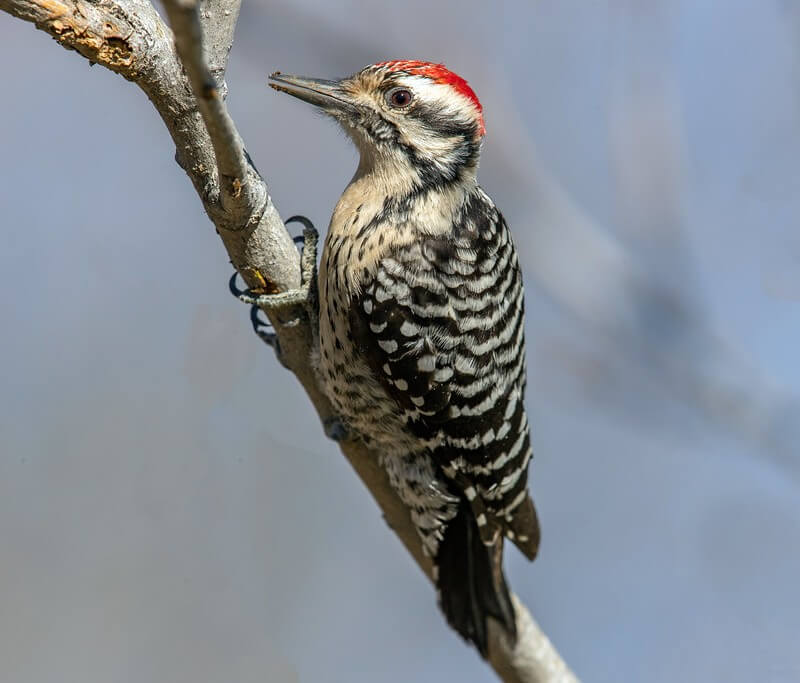
- Dryobates scalaris
- Size: 7″ (18 cm)
Identification and Color: The Ladder-backed Woodpecker has a small but straight bill with squared heads and stiff tails. They have neat black and white stripes on their bodies and wings. The underparts are white with black spots. Males have red crowns, and females have black crowns.
Habitat and Behavior: Likes hotter temperatures in the southeast United States and further into Mexico and beyond. Enjoys dry areas like deserts, brush, and thorn forests. Will forage by hopping around branches but stays hidden in trees or vegetation.
Diet: The Ladder-backed Woodpecker eats insects like caterpillars, larvae, and ants. They will also eat berries and fruit, including the fruit of cacti.
What does a Ladder-backed Woodpecker sound like?
Lewis’s Woodpecker
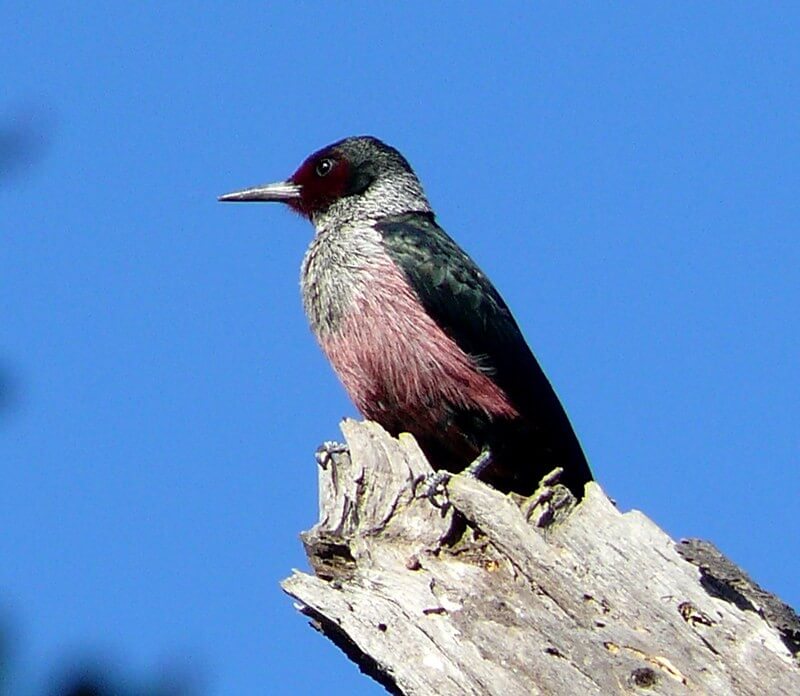
- Melanerpes lewis
- Size: 11″ (28 cm)
Identification and Color: They have long bodies, wings, and tails. Their bill is smaller but still sturdy. A dark red face, a black head, and a white collar. Black and green on top and a reddish-pink belly.
Habitat and Behavior: Lives between the southwest and northwest. Will live in downed or recently burned forests, river groves, or foothills. Flying slowly and deliberately, they can catch insects midair and sometimes perch in open areas.
Diet: The Lewis’s Woodpecker eats many different insects. Will also eat nuts, fruits, and berries.
What Does a Lewis’s Woodpecker sound like?
Northern Flicker

- Colaptes auratus
- Size: 12″ (30 cm)
Identification and Color: A fairly common large woodpecker, but size is where the similarities to other woodpeckers end. The male Northern Flicker is unique with a brown back, black bars and spotted breast. All North American Flickers have white rumps. There are also two different color groups of Northern Flickers – Yellow-shafted and Red-shafted. Yellow-shafted flickers have yellow underwings. Red-shafted flickers have reddish pink underwings.
Habitat and Behavior: Northern Flickers are hole-nesting birds, often making a home in a dead tree. Can be seen hopping around the ground while foraging or latched onto a tree eyeing a spot to search for food.
Diet: Northern Flickers mainly eat insects off the ground, but will also eat berries and nuts.
What does a Northern Flicker sound like?
Nuttall’s Woodpecker

- Picoides nuttallii
- Size: 7″ (18 cm)
Identification and Color: Males and females both have black and white striping throughout their bodies with some solid white underparts and some black spotting on the side of that. Both sexes have 2 narrow stripes on their heads. The main difference is males have a bright red patch on the top and very backs of their heads.
Habitat and Behavior: The Nuttall’s Woodpecker is located in the western half of California. They are permanent residents there and rarely go far from the nests they make. Specifically prefer to be in oak trees but may also be in cottonwood, sycamores, or willows. Foraging takes place in the trees mainly.
Diet: Nuttall’s Woodpeckers mainly eat insects they find in and around the trees. Will also eat some nuts, fruits, seeds, and berries.
What does a Nuttall’s Woodpecker sound like?
Pileated Woodpecker

- Dryocopus pileatus
- Size: 15″ (38 cm)
Identification and Color: These birds are mostly black with white stripes on their faces and necks. Both males and females have a brilliant red crest on their heads, but only males have a red stripe on their cheek. The Pileated Woodpecker is fairly large and has a long neck. They have a long and chisel-like bill.
Habitat and Behavior: Residents of the northeast and southeast mainly. They do not generally migrate. Favors anyplace with many trees, may be found at dead trees or even young trees depending on location. They forage by pecking into trees which is very loud.
Diet: The Pileated Woodpecker mainly eats the ants found in trees. They will also eat other insects, fruits, and nuts.
What does a Pileated Woodpecker sound like?
Red-breasted Sapsucker
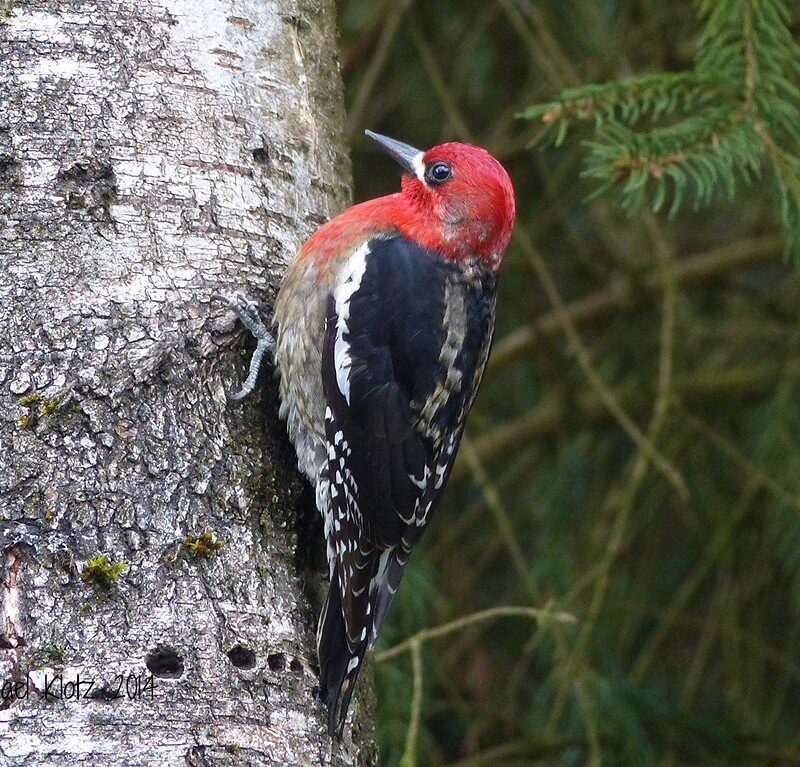
- Sphyrapicus ruber
- Size: 9″ (23 cm)
Identification and Color: The Red-breasted Sapsucker has a large head, long body, and chisel-like bill. A reddish head that extends to their throats. Black on top of their bodies with some white spots and grey, white, and black mixed underparts.
Habitat and Behavior: Likes to be in forests, orchards, and groves on the western coastline. They will forage on the sides of trees and make many shallow holes to find sap.
Diet: As the name implies, the Red-breasted Sapsucker enjoys tree sap, insects, and some small fruits. Will eat different insects found in trees as well.
What does a Red-breasted Sapsucker sound like?
Red-naped Sapsucker

- Sphyrapicus nuchalis
- Size: 8″ (20 cm)
Identification and Color: Males and females have red crowns and black and white large striped heads. The tops of their bodies and wings are mostly black, with some white. The underparts are mottled black and white. Males have red chins, and females have white chins. A medium-sized woodpecker with a sharp bill.
Habitat and Behavior: Located throughout the west, breeding in the north and wintering in the southern half. Likes mixed forests and woodlands, generally avoiding oak or pines during the breeding season. Will climb around trees and make many holes in them.
Diet: The Red-naped Sapsucker feeds on insects, fruits, and tree sap. May also eat some berries.
What does a Red-naped Sapsucker sound like?
White-headed Woodpecker
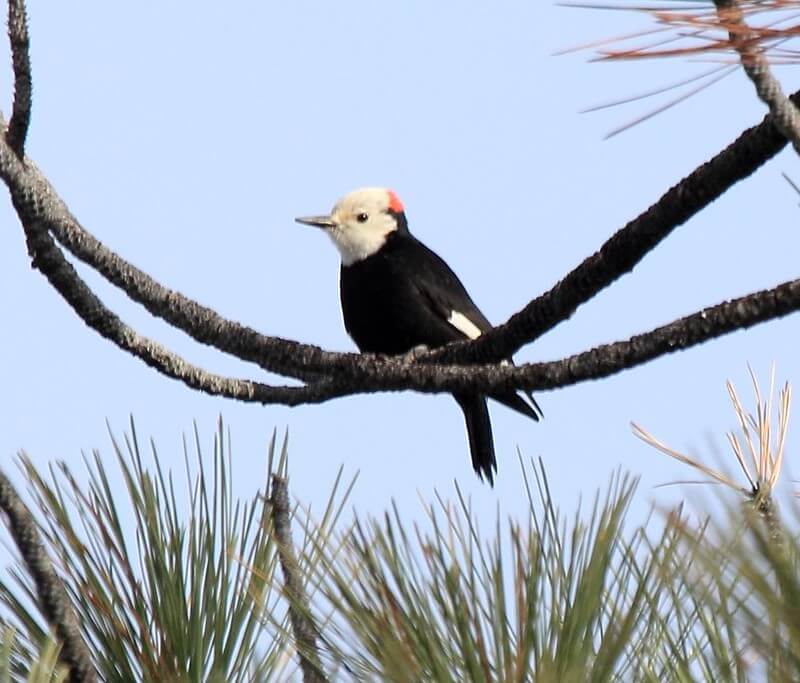
- Picoides albolarvatus
- Size: 8″ (20 cm)
Identification and Color: These birds have white faces and heads. The rest of their bodies are black. Males have a red patch towards the top of their heads. Medium-sized with long tails and wings. T hey have short and sharp bills.
Habitat and Behavior: Sparsely located in the west. They live in mountain forests with abundant pines and are usually not seen elsewhere. Forages by clinging to pine cones to get seeds out or making shallow holes in trees.
Diet: The White-headed Woodpecker will eat mostly pine seeds, depending on the season. Will also eat insects found in the trees.
What does a White-headed Woodpecker sound like?
Williamson’s Sapsucker
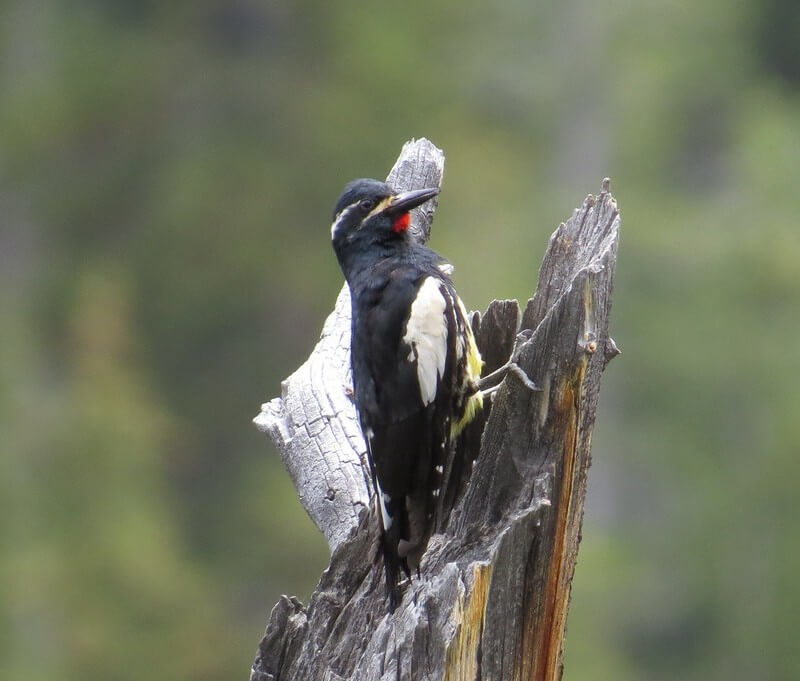
- Sphyrapicus thyroideus
- Size: 10″ (25.5 cm)
Identification and Color: Males are more solidly black, with white marks underneath and white stripes on the head. Males have a red throat patch. Females have brownish heads and black and white barring on their bodies. Both males and females have a yellow patch on their bellies. They have long wings for their stout bodies.
Habitat and Behavior: Found in different areas of the west, they like open forests that are mixed and mature. Forages by making small holes in trees and will also eat insects off the tree bark.
Diet: The Williamson’s Sapsucker enjoys insects, sap, and fruit. Generally eats a variety of insects during the breeding season.
What does a Williamson’s Sapsucker sound like?
Conclusion
In conclusion, woodpeckers are an important part of California’s ecosystem. They play a vital role in the health of the forests and woodlands of the state, providing food for other animals and helping to control insect populations. They also provide a unique and interesting sight for birdwatchers and nature lovers alike. With their bright colors and loud calls, they bring a sense of life and energy to the forests of California. With proper conservation efforts, woodpeckers can continue to thrive in the state for many years to come.
Before you go, be sure to check out our other articles about birds in California.
